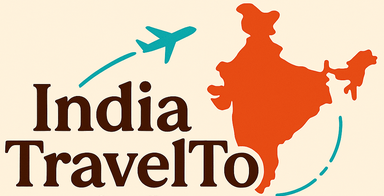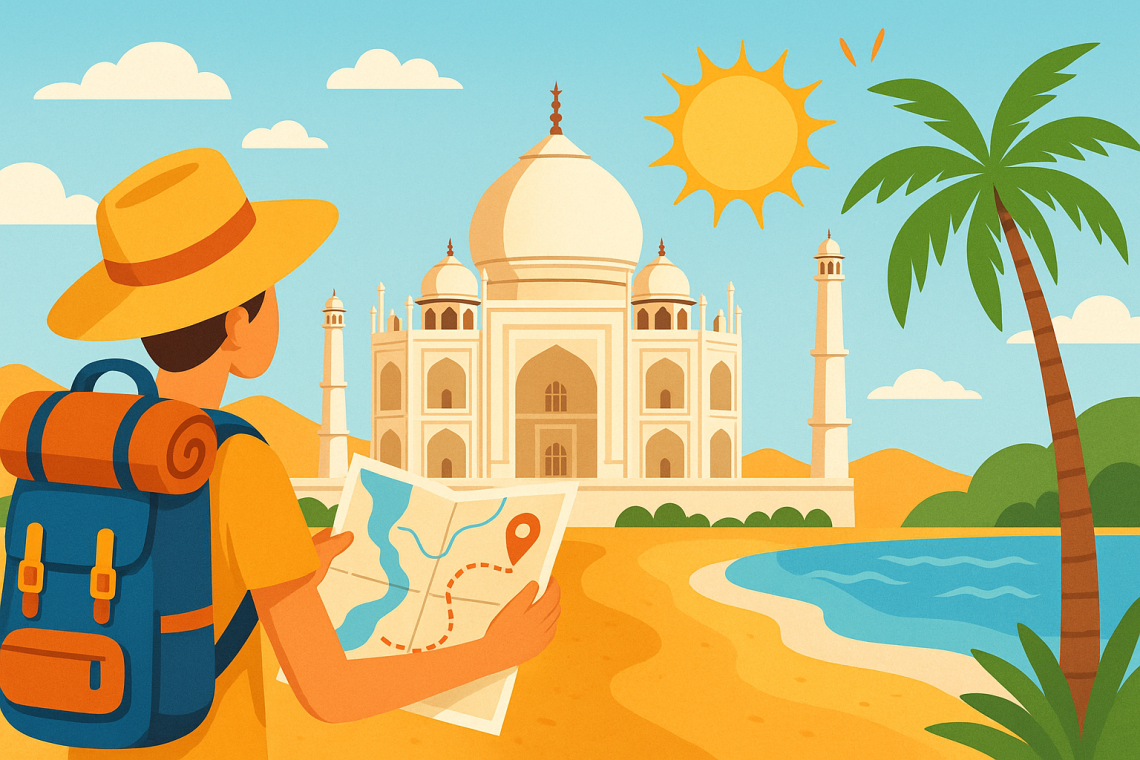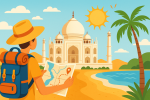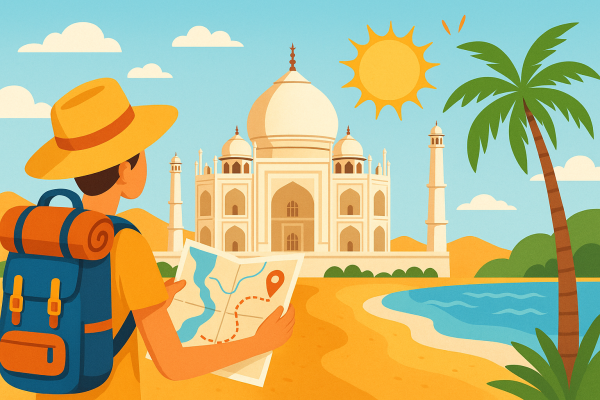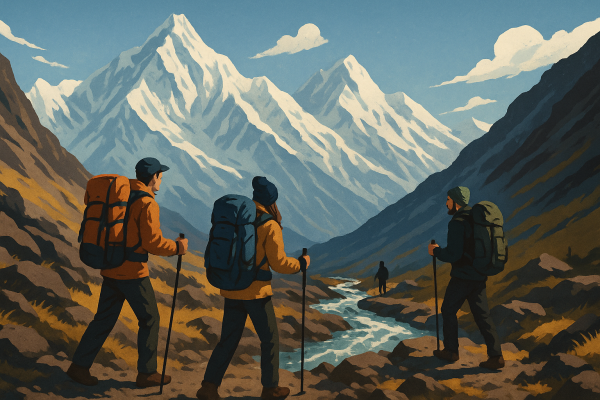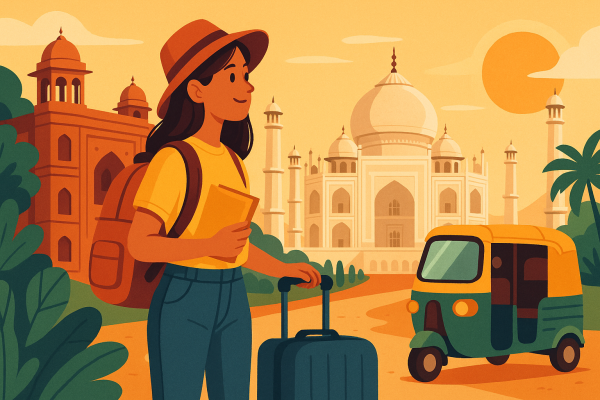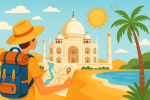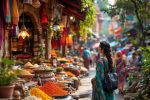The Best Time to Travel to India from the USA: Seasonal Insights
Dreaming of India? Discover the best time to explore this vibrant land! From the cool, dry winters perfect for trekking to the lush landscapes revealed after the monsoon, India offers a unique experience for every season. Learn how to snag the best flight deals from the USA, whether you’re seeking bustling festivals or tranquil backwaters. Uncover insider tips for planning your dream Indian adventure and start exploring today!
Important information
- India’s peak tourist season is October to March (winter), offering pleasant weather ideal for exploring but with higher prices.
- The monsoon season (June to September) brings heavy rain, especially in coastal and southern areas, but offers the cheapest travel rates.
- Shoulder seasons (April-May & September-October) provide a balance of comfortable weather and potentially lower costs.
- Northern India experiences hot summers and cool winters, while Southern India remains warm year-round.
- Booking flights 2-4 months in advance, traveling mid-week or during the off-season, and setting fare alerts can help secure the best flight deals.
Understanding India’s Climate and Seasons
India’s climate, heavily influenced by monsoons, presents diverse weather patterns. From October to March, winter brings enjoyable temperatures, perfect for exploring the country. December and January are the coolest months, although fog can occasionally occur. Summer follows, spanning from March to June, with intense heat, especially in the northern and central regions. The monsoon season arrives from June to September, bringing heavy rainfall to coastal and southern areas. A short post-monsoon period in September and October leads back to the cooler winter months.
Winter (October to March): Pleasant temperatures ideal for travel.
Coolest Months (December and January): These are the coolest months, with occasional fog.
Summer (March to June): Intense heat, particularly in northern and central regions.
Monsoon Season (June to September): Heavy rainfall in coastal and southern areas.
Post-Monsoon (September and October): Transition period back to winter.
The Climate of Northern and Southern India
Northern India experiences hot summers and cool winters. For a December or January trip, pack warm clothing.
Southern India remains warm and tropical year-round. Lighter attire is sufficient for a visit any time of year.
Weather Patterns: October to March
India boasts delightful, dry weather from October to March, making it the ideal time for tourists. December and January offer the coolest temperatures, so plan your visit accordingly.
Weather Patterns: June to September
India’s monsoon season, spanning from June to September, brings heavy rain and humidity, especially to coastal and southern regions. However, this period offers the cheapest travel rates, with flights and hotels significantly lowering their prices. This makes monsoon season a budget-friendly option, allowing travelers to experience India’s unique beauty enhanced by the rains and lush landscapes. While some wet weather is expected, the lower costs and vibrant scenery make it a worthwhile travel consideration.
Understanding India’s Travel Seasons
India offers diverse travel experiences across three distinct seasons.
Peak Season (October to March)
Pleasant weather invites exploration of historical sites, bustling markets, and vibrant festivals.
Shoulder Seasons (March to June & September to October)
Experience comfortable temperatures with fewer crowds.
Monsoon Season (June to September)
Discover lush landscapes and lower prices, though occasional heavy rainfall may disrupt travel plans.
Why Timing Matters for USA to India Flights
Planning a trip from the USA to India? Airfare varies significantly throughout the year. Peak season, spanning from October to March, sees the highest prices due to pleasant weather and increased demand. If you’re looking for budget-friendly options, consider traveling during the off-season (June to September), which coincides with the monsoon season and offers lower fares. For a balance of decent weather and potentially reduced costs, explore the shoulder seasons of April-May and September-October.
Factors Affecting Flight Prices
Planning a trip from the USA to India? Ticket prices can vary based on several factors.
Peak Season
Expect higher fares during peak seasons, from June 14th to July 30th and December 10th to 24th, due to increased demand.
Monsoon Season
Traveling during the monsoon season can often be more budget-friendly.
Look out for airline sales and promotions to save on your airfare. Your departure city and considering flights with layovers can also impact the overall cost.
Tips for Finding the Best Flight Deal
Looking to save on airfare? Flexibility is key. Consider traveling during the off-season or shoulder season for optimal pricing. Booking your flights 2 to 4 months in advance can also help. For even better deals, fly mid-week or during non-peak hours. Finally, set up fare alerts to catch those flash sales!
- travel during the off-season or shoulder season,
- book flights 2 to 4 months in advance,
- fly mid-week or during non-peak hours,
- set up fare alerts.
When to Visit India: Seasonal Guide
India shines brightest from October to March, the peak season when winter casts a pleasant spell. Warm, sunny days and cool nights define this period across much of the country. This inviting climate is perfect for trekking the Himalayas or relaxing on a southern beach. While northern India experiences cooler temperatures, sometimes with fog, in December and January—and the Himalayas become quite cold—southern India is at its prime after the monsoon, making November onwards the perfect time to visit.
Peak Season: October to March
India’s peak tourist season runs from October to March, offering pleasant weather and a vibrant array of festivals and cultural events. However, this popularity leads to increased prices for flights and accommodations. To save money, book your trip in advance. Alternatively, consider traveling during the shoulder seasons (April-May and September-October) for potential cost savings.
Shoulder Season: March to June
India’s shoulder season, spanning March to June, offers a delightful sweet spot: pleasant warmth before summer’s scorching heat and significantly fewer crowds than peak season. This makes it an ideal time for a visit.
Off-Peak Season: June to September
India’s monsoon season, spanning from June to September, offers budget-friendly travel opportunities with lower hotel and flight prices. However, be prepared for frequent rain and high humidity, so pack accordingly.
Month-by-Month Guide to Traveling in India
January
Experience pleasant weather, ideal for exploring Rajasthan and enjoying cultural festivals. The southern hill stations are also a great choice.
February
Pleasant weather continues, perfect for outdoor activities. Visit the Taj Mahal, cruise Kerala’s backwaters, or experience Goa’s vibrant carnival.
March
Temperatures rise, especially in the north, coinciding with the colorful Holi festival. Central and southern India remain comfortable.
April
Heat intensifies, making higher altitudes like the Himalayas and northeast ideal destinations.
May
Scorching temperatures make travel challenging except for coastal areas and hill stations.
June
Monsoon season begins, bringing cooling rains. Kerala transforms into a lush paradise, though some areas experience heavy downpours.
July
Monsoon continues with stunning scenery for nature lovers and photographers. Travel can be difficult.
August
Monsoon rains continue, offering lush scenery and lower prices. Target areas with less rainfall.
September
Monsoon retreats, and weather improves. Kerala is vibrant with post-monsoon greenery.
October
Pleasant weather returns to most of India, marking the start of peak tourist season.
November
Pleasant weather continues, ideal for travel and experiencing Diwali, the festival of lights.
December
Comfortable temperatures mark peak season. Explore Rajasthan, enjoy Christmas in Goa, or discover other exciting destinations.
Visiting India in January
Discover India in January and experience pleasant weather perfect for sightseeing and outdoor activities. India’s vibrant January festivals offer a unique cultural immersion.
Visiting India in February
February in India offers delightful weather, pleasantly dry and perfect for outdoor adventures. It’s a great time to explore the country’s diverse attractions and landscapes, discovering a wealth of experiences.
Visiting India in March
In India, March brings a welcome shift from the cold of winter to the warmth of summer, offering comfortably warm days and cooler nights. This month is famous for Holi, the vibrant and joyful festival of colors.
Visiting India in April
India experiences varying temperatures in April. Northern regions become hotter, while the south enjoys a milder climate. For a comfortable trip, plan activities during cooler times of the day.
Visiting India in May
India’s northern plains experience intense heat during May, with many cities averaging over 95°F (35°C). The Himalayas offer a cool escape in hill stations such as Shimla and Manali. To avoid the worst of the heat, consider indoor activities during the hottest parts of the day.
Visiting India in June
Escape India’s scorching summer heat this June as monsoon season begins, bringing refreshing rains and lower travel prices. Be prepared for occasional showers.
Visiting India in July
Traveling to India in July means experiencing the monsoon season. Be prepared for heavy rainfall and potential travel delays, so consider planning indoor activities. While the rain may disrupt travel plans, it also transforms the landscapes into vibrant green scenery, leaving the air fresh and clean.
Visiting India in August
Traveling to India in August means experiencing the monsoon season. Be prepared for heavy rainfall and potential flooding in some areas. This is also the time when India’s landscapes become incredibly lush and vibrant.
Visiting India in September
As India’s monsoon season concludes in September, the skies clear to reveal breathtaking landscapes, making it a prime time for a visit. With fewer crowds and lower prices, September offers an ideal travel experience. Imagine exploring lush scenery without the usual summer throngs. While occasional showers might linger in some areas, the post-monsoon period unveils a unique charm, showcasing India’s natural beauty in a truly spectacular way. Traveling to India in September offers several advantages:
- Pleasant weather: the monsoon rains have subsided, leaving behind cooler temperatures and lush greenery,
- Fewer crowds: enjoy popular attractions with significantly less congestion compared to peak season,
- Lower prices: take advantage of reduced rates on accommodations and flights,
- Unique landscapes: experience the beauty of India’s landscapes rejuvenated by the monsoon rains.
Visiting India in October
October is the perfect time to experience India’s peak tourist season. The pleasant weather creates ideal conditions for exploring the country’s diverse landscapes and rich cultural heritage. The month is also filled with vibrant festivals and events, adding another layer of excitement to your trip.
Visiting India in November
Visiting India in November offers several advantages. The weather is pleasant, making it comfortable to explore the country’s diverse landscapes, from the mountains to the coasts. November also coincides with Diwali, the “festival of lights,” a vibrant cultural celebration featuring spectacular fireworks and candle displays. Experiencing this unique festival adds another dimension to a November trip to India.
Visiting India in December
December is a wonderful time to explore India, thanks to its cool, pleasant weather. This ideal climate makes it a popular time for tourists, who can comfortably experience the country’s many regions and festive celebrations. Moreover, December’s reduced foliage in national parks offers excellent wildlife viewing opportunities.
Cultural Experiences and Festivals in India
India’s cultural heritage thrives through a vibrant tapestry of festivals. These diverse celebrations offer a unique glimpse into the country’s rich traditions, with incredible events unfolding throughout the year. In March, Holi, the Festival of Colors, erupts in a vibrant explosion of hues. Later, in October or November, Diwali, the Festival of Lights, illuminates the nation. These immersive experiences showcase India’s varied customs, while regional festivals further enrich this vibrant cultural mosaic.
Holi Festival: Celebrating Colors in March
Every March, Holi, the festival of colors, explodes into a vibrant celebration of spring’s arrival and the triumph of good over evil. Travelers find its energy unforgettable and immersive.
Diwali: The Festival of Lights in November
Diwali, the festival of lights, illuminates November, celebrating the triumph of good over evil and the dispelling of darkness. This vibrant celebration provides travelers a unique cultural immersion.
Travel Planning Tips for India
Planning a trip to India? Booking your flights 2-4 months in advance is recommended to secure the best deals. Flying mid-week or during the off-season (avoiding summer and monsoon) can also help you save money. Setting up fare alerts allows you to track price drops and seize last-minute opportunities. Remember, flexibility with your travel dates is key to finding an affordable flight.
Booking in Advance and Flexible Travel Dates
Planning ahead and being flexible with your travel dates can lead to significant savings. Booking flights and accommodations well in advance often unlocks lower prices. Even greater deals can be found by adjusting your travel dates, especially during peak seasons.
Understanding Flight Fares and Cost-effective Flights
Airfare to India varies greatly throughout the year. Travelers can often find more affordable flights during the off-season, which typically runs from June to September, due to lower demand.
